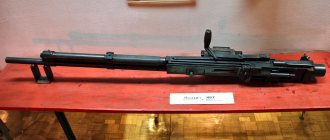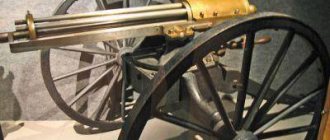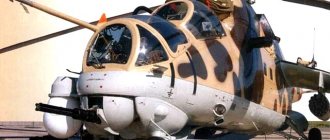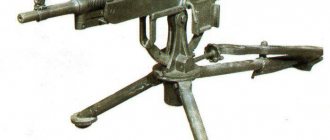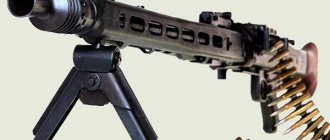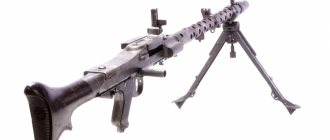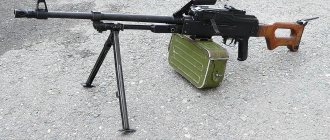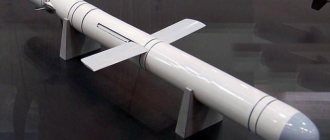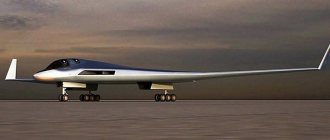| This article requires additional links for verification . |
Machine gun type
| MG 81 | |
| MG 81 (top) and MG 81Z (boxed) | |
| Type | Machine gun |
| Place of origin | Nazi Germany |
| Service history | |
| Used | Nazi Germany |
| Wars | The Second World War |
| Production history | |
| Options | MG 81Z |
| Characteristics | |
| Weight | 6.5 kg (14.33 lb) |
| Length | 965 mm (38.0 in) (with flash suppressor) |
| Barrel length | 475 mm (18.7 in) |
| Cartridge | 7.92×57mm Mauser |
| Action | With dedication |
| Rate of fire | 1,400–1,600 rounds/min |
| starting speed | 705 m/s (2,310 ft/s) (SS ball ammunition) |
| Feeding system | With ribbon |
MG 81
There was a German belt-fed 7.92×57mm Mauser machine gun that was used in flexible mounts in World War II Luftwaffe aircraft in which power it replaced the senior drum magazine-fed MG 15.
The MG 81 was developed by Mauser as a derivative of their successful MG 34 general purpose machine gun. The main focus of development was on reducing production costs and time, as well as optimizing the machine gun for use in aircraft. Developed in 1938/1939, produced from 1940 to 1945.
In 1942, a special coaxial machine gun MG 81Z (suffix Z
means
Zwilling
, meaning "twin").
It combined two weapons on one mount to provide even more firepower with a maximum rate of fire of 3,200 rounds. per minute, without taking up much more space than a standard machine gun. Towards the end of the war, many examples were delivered to the army and equipped for use in ground combat with a shoulder rest and bipod. German twin aircraft MG 81 Z. View from the Luftwaffe manual, 1944.
Applications [edit]
The MG 81Z was used in many unique Luftwaffe combat aircraft installations, such as a pair of MG 81Zs (four guns in total) mounted in the hollow tail of a Dornier Do 217. Designated R19 (R for Rüstsatz) as a factory conversion/upgrade kit, it allowed the Do 217 pilot to shoot at pursuers.
Another use was Gießkanne
(
leika
), an externally mounted capsule containing three pairs of guns, for a total of six guns and their ammunition. Capable of firing at a cyclic rate of 9,000 rounds per minute, it was mounted on a Junkers Ju 87 or Ju 88 in an underwing mount and used for strafing ground targets. [1]
MG 81 machine gun
MG 81 (German: Maschinengewehr 81) is a 7.92 mm German aircraft machine gun from World War II used as an infantry machine gun.
History of creation and production
The MG 81 was developed by Mauser based on the design of the experimental MG 32 to replace the MG 15 and MG 17 previously adopted by the Luftwaffe. The main tasks set for the developers were the unification of aviation weapons, increasing the tactical and technical characteristics and manufacturability of the new machine gun.
Aviation machine gun MG 81 in turret version
Production began in 1939, mass production was mastered at the end of 1939 and continued until 1945. Between the beginning of 1939 and the end of 1944 alone, over 46 thousand MG 81 machine guns of all modifications were produced. Along with Mauser , several other companies were involved in the production of MG 81 under contracts: LODietrich , H.Krieghoff , ICWagner and Nord-deutsche Maschinenfabrik .
Options and modifications
- Aviation machine gun MG 81 - produced in turret, wing and synchronous versions. The first machine guns were produced with a 600 mm barrel, but a standardized version with a 476 mm barrel went into mass production. Used on aircraft Do 217 , FW 189 , Ju 88 , He 111H , etc.
- Light machine gun MG 81 - infantry version, equipped with a bipod and a butt, at first it had a metal shoulder rest attached to the box, then an additional handle for the left hand was strengthened on the rest, machine guns with a permanent wooden butt were fired in a small number.
Light machine gun MG 81 - MG 81Z - a twin machine gun mount with double-sided belt feeding, introduced in 1942, had a mass of 12.9 kg, a length of 890 mm and a rate of fire of more than 3000 rounds per minute, has one pistol grip with a single trigger, a ring sight, sleeves for feeding cartridge belts and withdrawing links , sleeve collector.
German soldiers at an MG 81Z machine gun at a field airfield
Design and principle of operation
The MG 81 automatic operates on the recoil principle with a short barrel stroke. Locking, like the MG 34, is carried out by turning the combat cylinder. The impact mechanism is striker type. The trigger mechanism allows only continuous fire. The machine gun has a push-button safety located above the pistol grip. The slide-type feed mechanism allows for double-sided feeding of a semi-closed link belt, similar to the MG 17 . To soften the impact of the moving system in the rearmost position, a buffer spring is mounted in the rear part of the receiver. The barrel is cooled by air. The original design features of the MG 81 were the following: rigid connection of the firing pin to the bolt; to break the cartridge primer, the energy of two springs is used at once - a return spring and a mechanism in which the movable tube, being in the rear position, is kept cocked, which makes it easy and unhindered to remove the bolt from the receiver or, conversely, install it.
Operation and combat use
The machine gun was adopted in 1938, mainly entering service with the Luftwaffe, but a number of MG 81s were supplied to the Kriegsmarine, where they were installed in anti-aircraft installations on boats and transport ships; already in the spring of 1943, MG 81 light machine guns began to enter service with the “eastern” armed formations that took part in anti-partisan operations; Since 1944, they began to enter service with Luftwaffe airfield divisions, but by July 1944 there were still 33,164 units in storage. unused machine guns of this type (20,396 MG 81 aircraft machine guns and 12,768 MG 81Z ); after the creation of the Volkssturm in the fall of 1944, they entered its service.
Volkssturm soldiers with MG 81 in East Prussia, 1945
Video
Shooting from a machine gun, handling weapons, etc.:
Shooting from an MG 81Z machine gun
| TACTICAL AND TECHNICAL CHARACTERISTICS OF THE MG 81 MACHINE GUN | |
| Manufacturer: | Mauser Werke AG and others |
| Cartridge: | 7.92x57mm Mauser |
| Caliber: | 7.92 mm |
| Weight without cartridges: | 6.5 kg |
| Weight with cartridges: | n/a |
| Length: | 965 mm |
| Barrel length: | 475 mm |
| Number of rifling in the barrel: | 4 right-hand |
| Trigger mechanism (trigger): | Impact type |
| Operating principle: | Short-stroke recoil |
| Rate of fire: | 1500–1600 rounds/min |
| Fuse: | Push-button safety on the right side, above the pistol grip |
| Aim: | Front and rear sights, anti-aircraft ring sight |
| Effective range: | 500 m |
| Sighting range: | 1000 m |
| Initial bullet speed: | 705–790 m/s |
| Type of ammunition: | 50 or 250 round belt |
| Number of cartridges: | 50, 250 |
| Years of production: | 1939–1945 |
Specifications [edit]
MG 81
- Weight: 6.5 kg (14 lbs)
- Length: 915 mm (36.0 in) (965 mm (38.0 in) with flash suppressor)
- Muzzle velocity: 705 m/s (2,310 ft/s) (sS ball ammunition), 760 m/s (2,500 ft/s), 785 m/s (2,580 ft/s) or 790 m/s (2,600 ft/s) c)), depending on the type of ammunition
- Rate of fire: 1400–1600 rpm (sS ball ammunition).
MG 81Z
- Weight: 12.9 kg (28.44 lb)
- Length: 915 mm (965 mm with flash arrester)
- Muzzle velocity: 705 m/s (2,310 ft/s) (sS ball ammunition), 760 m/s (2,500 ft/s), 785 m/s (2,580 ft/s) or 790 m/s (2,600 ft/s) c)), depending on the type of ammunition
- Rate of fire: 2800–3200 rpm (sS ball ammunition).
b 1938 Ts. nDMuYN B LYuYAYANBNE OPNKHGBNDYARBN NM ONJEK RNKEIN B YNMZHE 1939 Ts. 15 X MG.17. bOPNVEL, Y LNLEMRS ONYARSOKEMKH MU BNNPSFEMKHE OSKELERYU MG 81 ONRPEAMNYARE ETSN B YUVEYARBE MYUYARSOYUREKEMNTSN BNNPSFEMKH SFE NROYUKYU, SCHRN NPSFHE HYAONKEGNBUKNYAE, B NYAMNB MNL, B ONDBHFMSHU RSPEKEMSHU LEUUMHGHPNBYUMMSHU H PSVMSHU SYARYUMNBYUU.
mYUVKHMYU YAN BRNPNI ONKNBKHMSH 30-U TsNDNB, I BBNDNL MNBNI YKYUYAKHTHYUZHHNMMNI YAHYARELSH YUBKHYUZHNMMSHE OSKELERSH ONKSVKHKH MNBSHE NANGMYUVEEMKH, B NRKHVHE NR PUMEE OPHLEMEM MNTS NANGMYUVEMHЪ ON TsNDS ONYARYUMNBYKH MU BNNPSFEMKHE. b YANNRBERYARBHH I MNBNI YAKHYARELNI NDMYU HKKH DBE OEPBSHU ZHTPSH NGMYUVYUKH YUKHAP NPSFKH B YAYUMRKHLERPYUU, YUY ASHKN OPKHMIRN B TseplyumHKH, ONYAKEDMЪ ZHTPYU YAKSFHKYU ONP'DYNBSHL MNLEPNL YNMYARPSYRKHBMNTSN BYUPHYUMRYU. eYAKKH YUKHAP NPSFKH KHGLEMKYA B OPNZHEYAYAYE LNDEPMKHGYUZHKH, RN MNBSHI YUKHAP YARYUBKHKYA ONGYUDH NYAMNBMNTSN NANGMYUVEHMKH VEPEG YNYASCH VEPRS-DPNAE. RUYHL NAPUGNL, OSKELER MG.81 YARIUK OEPBNI YNMYARPSYZHHEI B JUKHAPE 8 YAL.
yUBRNLYURHYU MG.81 PYUANRYUKYU ON OPHMZHHOS NRDYUVH I YNPNRYHL UNDNL YARBNKYU. gyUOKHPYUMKHE, YUY X S MG.34, NYASYYARBKKNYAE ONBNNPNRNL ANEBNI KHVHMYH, NDMYYN, B NRKHVHE NR OEUUNRMNTsN MG 34 B YUBHYUZHNMMNL MG 81 ASHKYU OPHLEMEMYU ANKEE LNYYU ASTEPMYU OPSFKHMYU B RSHKEMNI VYUYARKH YARBNKEMNI YNPNAIKH. sDYUPMSHI LEUUMHGL - SDYUPMKHYNBNTSN RHOYU. YaOSAYNBNI LEUUMKHGL ONGBNKK BEYARKH RNKEIN MEOPEPSHBMSHHI NTsNME. b YAOSYAYNBNI YNPNAYE LNMRKHPNBUKYA OPEDNUPYUMHREKE TKYUFYNBNTSN RHOYU. ONDUCHYKHI LEUUMKHGL ONKGSMYNBNTSN RHOYU ONGBNKK NYASYYARBKRE DBSYARNPNMMCHCH ONDUVS OSKELERMNI LERYUKKKHVEYAYNI KEMRSH I ONKSGULYMSRSHL GBEMNL Gurt 17/81, SMHTHZHHPNBUMMNI DK HYAONKEGNBYUMKH B ANKEE PYUMMKHU OSKELERUU MG.17. nUKYUFDEMKHE YARBNKYU - BNGDSMNE.
oSKELERSH MG.81 OEPBSHU YAEPHI BSHOSYAYUKHYAE YAN YARBNKYULH DKHMNI 600 LL OPH NAYEI DKHME NPSFKH 1065 LL, NDMYYN ONYAYNKEYS OPH BSHIANYKHU YAYNPNYARU YAYULNKERNB NPSFHE MU OND BHFMSHU KYUTERYU DNYURRNVMN RPSDMN ONDDYUBYUKNYAE MYUBEDEMHCH OPH ANKEHU YSPYANBSHU STSKYU, RN YARBNKSH ASHKH BSHMSFDEMSH SYNPNRHRE DN 475 LL. OPH NVEME LYUKNL BEYAYE OSKELERYU (6.5 YTS) YAYNPNYARPEKEMNYARE ONDMJKYUYAE I 1200 DN 1600-1800 BSHYARP/LHM, OPYURHVEYAYH ME SYARSOYU GMYULEMHRNLS YANBERYAYNLS yuyuyaS , ASDSVKH OPH SCHRNL GMYUVHREKEMN KETSVE KH REUMNKNTSKHVMEE NREVEYARBEMMNTSN OSKELERYU. oPUBDU, YAOPYUBEDKHBNYARKH PUDH, YARNHR NRLERHRE, VRN Y LNLEMRS ONEBKEMKH MG.81 yuyuya SFE BSHOSYAYUKYA YUY LHMHLSL ORRE KER, Yu YURSYUKEMNYARE YUBKHYUZHNMMSHU OSK ELERNB BKHMRNBNVMNTSN YUKHAPYU GMYUVHREKEMN YAMKHGHKYUYAE. REL ME LEMEE, OSKELER MG.81 DNBNKEMN LYUYANBN OPHLEMKYA MU PSVMSHU X LEUUMHGHPNBUMMSHU NANPNMHREKEMSHU SYARYUMNBYUU BYAU LMNTSNLEYARMSHU YAYULNKERNB KCHTRBYUTTE. b MEONDBHFMNL, MUYARSOYUREKEMNL BYUPHYUMRE MG.81 OPHLEMKYAJ, TsKYUBMSHL NAPUGNL, RNKEYN YUY BIAONLNTSYUREKEMNE BNNPSFEMKHE, LNMRKHPSYAE B OEPEDEKNVMSHU YNLOKEYRUU YU LNKERNB, OPKHGBYUMMSHU "PUANRYURE" OH OUNRMSHL ONP'DYUL OPNRKHBMKHYU. dK SCHRHU ZHEKEY ASHKH PYUGPYUANRYUMSH YAOEZHYUKEMSHE OSKELERMSHE YNMREIMEPSH Waffenbehälter 81 A, B YNRNPSHU SARYUMYUBKHBYUKHYAE ON 2, 3, 4 HKH 6 OSKELERNB MG.81. ynMREIMEPSH ONDBEKHBYUKKHYAE OND YPSHKN ANLAYUPKHPPNBYKHYNB Ju.87, OPH LSPLNBYUU YANGDUBUYU NVEME BSHYANISCH OKNRMNYARE NTsM.
dK HYAONKEGNBYUMKH MG.81 B YUVEYARBE RSPEKEMNTSN ASHKYU PYUGPYUANRYUMYU ETSN YAOEZHHYUKEMYU LNDKHTHYUZHKH I ONBSHIEMMNI YAYNPNYARPEKEMNYARECH (DN 3200 BSHYARP/LHM). schRNTSN DNAHKHYAE, YANGDUB YAOYUPEMMSCH SYARYUMNBYS MG.81 Z (MEL. Zwilling -YAOYUPEMMSHI), I DBSYARNPNMMHL KEMRNVMSHL OHRYUMKHEL. dK SOPIUBKEMH NTsMEL OKHYARNKERMYU PSYNRYYU YAN YAOSYAINBSHL LEUUMHGLNL PUYAONKYUTSYUKYUYAE MU KEBNL OSKELERE. lNDEKE MG.81Z YANUPYUMHKYUYAE MU BNNPSFEMHH DN YAYULNTSN YNMZHYU BNIMSH, SYARYUMYUBKHBYUYAE MU BYAU ANLAYUPDHPNBYHYUU.
osKELER LNMRKHPNBUKYA B LMNTsNVHYAKEMMSHU PSVMSHU SYARYUMNBYUU: Linsenlafette (KHMGNBSHEE SYARYUMNBYUH, YUY MYUOPHLEP MU Ju-88), Fensterlafette (SYARYUMNBYKH B NYMYUU, MYUOPHLEP ANPRNBSH E MU mE-111), Kuppellafette (YSONKEMSHE SYARYUMNBYH), Kurbellafette (ONBNPNRMSHE SYARYUMNBYH), Walzenlafette (PNKKHYNBSHE SYARYUMNBYH ), Schwenkarmlafette (ONBNNPNRMN-PSHVYUFMSHE SYARYUMNBYKH).
UBNYARNBSC VYUARE ANLAYUPKHPPNBIKHYNB chMYEPYA Ju.87 X HYARPEAHREKEY Bf.110 ONGDMKHU BYUPKHYUMRNB GYUYKHYUK OSKELER MG 81Z, YALNMRKHPPNBYUMMSHI MU RSPEKEMNI SHYPYUMKHPNBYUMM NI SYARYUMNBYE Gleitschinenlafette (DNYAKNBMN, "PEKEYANBU SYARYUMNBYU") GSL-81Z.
oNLHLN LMNTsNVHYAKEMMSHU PSVMSHU RSPEKEY, TsDE LNMRKHPNBUKHYAE OSKELERSH MG 81 MYUPЪDS I ANKEE YARYUPSHLH MG 15, MYUKHANKEE UYUPYUREPMNI ASHKYU MHFMЪ RSPEKE Bodenlafette 81Z - D NYAKNBMN "MHFMЪ SYARYUMNBYU" HKKH YANIPYYUYEMMN "Bola 81Z", PYYAONKNFEMMYU B GYUDMEI VYUYARKH "BUMMSH" ANLAYUPDHPNBYKHYNB chMYEPYA Ju.88 ANKEHMYARBU PUMMHU BEPYAKHI. ShchRYU SYARYUMNBYU LNTSKYU NRYKhDSHBUREYA BMHG, ЪБКЪЯЭ NDMNBPELEMMN BUNDNL B YAYULNKER DK SHCHYHOYUFYU. OSKELER MG 81Z, YALNMRKHPNBUMMSHY B MEI KHLEK STSKSH MYUBNDYH +\-43 TSPUDSYU B YARNPNMSH X NR 0 DN 40 TSPUDSYANB BMHG.
OND OSKELER MG 81Z ASHKYU YANGDUMYU NDMYU HG OEPBSHU B MELEZHYNI YUBHYUZHHH DHYARYUMZHHNMMN-SOPIUBKELYU AYUYEMMYU SYARYUMNBYU FDL 81 Z (Fernbedienbare Drehlafette - DHYYYUMZHNMMN-SOP YUBKELYU ONBNNPNRMYU SYARYUMNBYU), NYAMYUYYUELSH PUGKHVMSHLH YAHYARELYULH DKHYARYUMZHNMMNTSN SOPYUBKEMKH, HP FA-1 DN FA-15 (Fernantrieb - “SDYUKEMMNE SOPYUBKEMKHE") ShchRKH SYARYUMNBYKH HYAONKEGNBYUKHYAE MU P'DE LNDEKEY ANLAYUPDHPNBYKHYNB UEIMYEKE mE.177, YU RUYFE MU PUGBEDVHYUU yuPUDN Ar.240, HYAOSHRSHBYUKHYAE MU SHCHYAOEPKH LEMRYUKEMSHU LYUHMYU Ju.288, X FW.191.
yBKHYUZHNMMSHY OSKELER MG.81 NRMNYAHKYY Y NDMNLS XG KSVIKHU OSKELERNB SCHRNTSN RHOYU. ETSN OPNYARYU YNMYARPSYZHH YAONYANAYARBNBUKYU SDNAYARBS B SHYYAOXYURYUZHHH. nPHTSKHMYUKEMSHLH NYNAEMMNYARLH YNMYARPSYZHKH MG.81 ASHKN YAKEDSCHIE: FEYARINE YANEDHMEMKHE SDYUPMHYU I GYURBNPNL; DK PUGAHRKH YUOYACHK OYURPNMY HYAONKEGNBUKYUYAE SCHMEPTsKH YAPYUGS DBSU OPSFHM - BNGBPYURMNI H ANEBNI; SYARPNIYARBN BNGBPYURMNTSN LEUUMKHGLYU, B YNRNPNL ONDBHFMYU RPSAYU, MYUNDJAE B GYUDMEL ONKNFEMHH, SDEPFKHBUKYUYAE MU ANEBNL BGBNDE, VRN ONGBNKER KETSIN H AEYAOPEORYA RBEMMN DNYARYURE GURBNP KH YARBNKEMNI YNPNAIKH KKH, MUNANPNR, SYARYUMNBHRE ECN.
OSKELER MG.81 (NYANAEMMN ETSN LNDEKE MG.81Z) MUJEK OPHLEMEMHE KH B BNEMMN-LNPYAYNL TKNRE, TsDE SARYUMYUBKHBUKYA MU YUREPYUU KH RPYUMYONPRMSHU YASDUU DK ANPEASH I MKHGYNKERYKHLH YAYULNKERYULH OPNRKHBMKHYU. oSKELERSH LNMRKHPNBUKHYAE B NDHMNVMSHU, YAOYUPEMMSHU H YAVERBEPEMMSHU GEMKHRMSHU SYARYUMNBYUU. b YNMZHE BNIMSH, YUY X OSKELERSH MG 15, OSKELER MG 81 ME KHGAEFYUK SVYARKH ASHRE HYAONKEGNBUMMNL B OEUNRE, ONYAINKEYS YASYYARBEMMSHU NRKHVHI ON YAPYUBMEMHCH YAN RYURMSHL OSKELERN L MG.34 YUBHYUZHNMMSHY OSKELER ME KHLEK, UNRЪ OPH GMYUVHREKEMN ANKEE BSHYANINI REUMKHVEYAYNI YAYNPNYARPEKEMNYARKH, FHBSVEYARE YARBNKYU MG.81 ASHKYU GMYUVHREKEMN MHFE.
mYUPЪDS I Mauser, OPNHGBNDYARBNL MG.81 OH YNMRPUYRYUL GYUMKHLYUKHYAE EYE MEYAINKEIN THPL: LODietrich, H.Krieghoff. ICWagner X Nord-deutsche Maschinenfabrik. bYaETsN B 1939 - 1944 CC. ASHKN BSHOSYEMN ANKEE 46,000 YUBKHYUZHNMMSHU OSKELERNB MG.81 BYAEU LNDKHTHYUZHHI.
